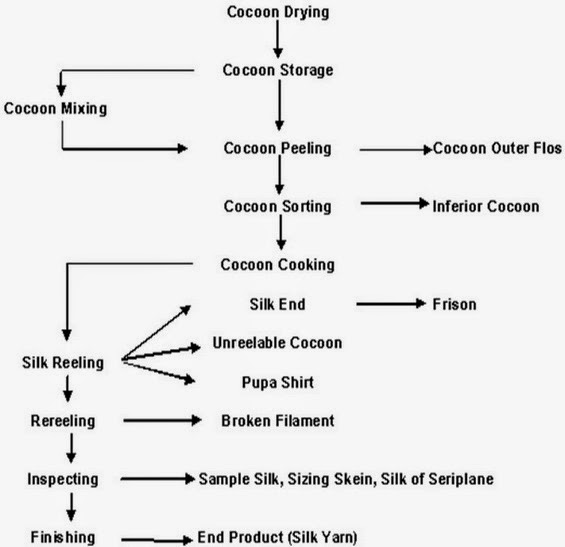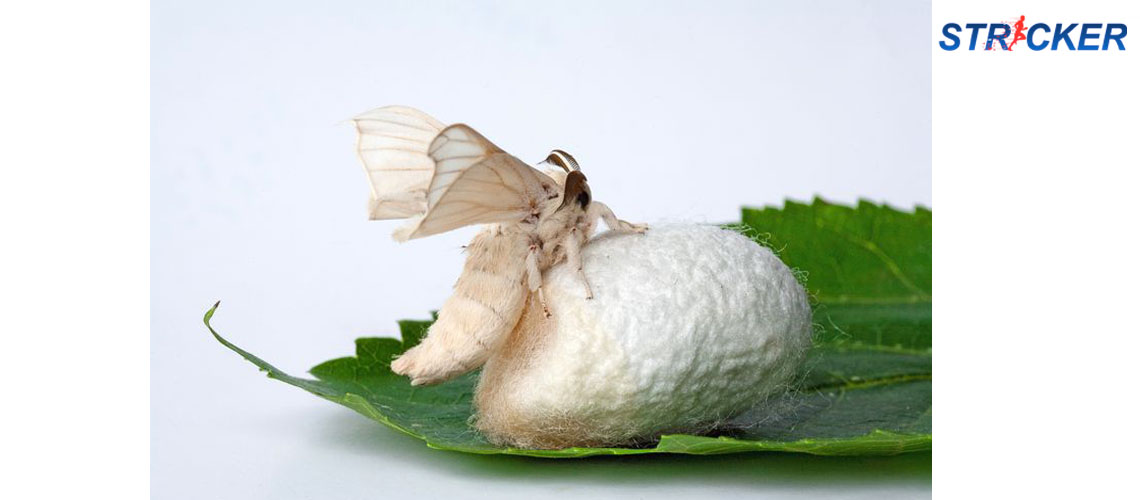Silk Fibre
Production of Silk Fibre- is different from that of other natural fibers. There are many steps involved in silk manufacturing.
- Cultivation of Cocoons (Sericulture)
- Filature Operations
- Manufacturing of Silk Yarns
- Finishing of Silk Fabrics
Sericulture has a long and colorful history unknown to most people. For centuries the West knew very little about silk and the people who made it. Pliny, the Roman historian, wrote in his Natural History in 70 BC “Silk was obtained by removing the down from the leaves with the help of water…”. For more than two thousand years the Chinese kept the secret of silk altogether to themselves. It was the most zealously guarded secret in history.
Manufacturing Process for Silk Yarns:
Silk is a fine translucent fiber produced from the silk worm. The manufacturing process of silk starts with the rearing of cocoons .There are many varieties of the silk worm from which the silk fiber can be obtained. However, it is found that the fiber obtained from the larva of Bombyx mori is of commercial value. The process of obtaining silk fiber from Bombyx mori requires careful nourishment of the cocoons which is put throught hes pinning process.
The process of cultivating the silkworm for the production of raw silk is called assericulture. Silk fiber is a continuous filament fiber consisting of the fibroin, which is connected together with the silkgum, sericin. This natural protein or fibroin is secreted from two salivary glands. (You are reading production of silk fibre)
Life cycle of the moth
- The egg, which develops into a larva, or caterpillar–the silkworm
- The silkworm, which spins its cocoon for protection, to permit development into the pupa
- The pupa emerges from the cocoon as the moth.
- Female moth lays eggs, so continuing the life cycle.
They may be hatched three times a year .The female moth lays around 350 to 400 eggs and the moths die soon after. As they are subject to hereditary infection, the eggs from infected moths are destroyed which results in to production of fine silk. Larvae of about 3 mm are hatched from the eggs. For about 20 to 30 days, they are carefully nurtured and are fed five times a day on chopped mulberry leaves. Ideal temperature 23c-27c, humidity is 65%-80%.The silkmoth lays eggs,
Production of Silk Fibre-Pathway
Sexing
- Silk of moth caterpillars has been used for textile manufacture.
- When sexing pupae are used by identification of male and female pupae by looking at the back.
- Have to do sexing on 8th day after pupation. Then cut the cocoon do not separate cut top, and then place the cocoons in a box like drawer.
- Cover the box with tissue paper and two boxes separate male and female.
Mating
The silk-moths cannot fly because their bodies are too heavy in relation to their wings. Male’s silk-moths die soon after mating while one single female silk-moth lies from 300 to 500 tiny eggs before she dies. The eggs hatch into the silkworms in spring time and the complete cycle takes approximately about two months.(You are reading production of silk fibre)
  |
- In 11thday, just after emergence mating with male and female by both are coupling.
- Mating for about one day every 30 minutes ejaculate sperms.
Decouplin
Egg laying
Silk moths lay eggs on specially prepared paper by using paper card method.
  |
| Laying eggs |
Chemical treatment of eggs
- Formal dehyde treatment (2%)-When immersing eggs are disinfected.
- Acid treatment (1.1 5g Hcl)-eggs are immersed for 5 minuets
- Washing in running water
- Air drying-keeping under the fan
Incubation
- 1st day to 7th keep the eggs rapped in a tissue paper.
- 8th day-black boxing, eggs are rapped with black paper or put in to black box to prevent irregular hatching.
Hatching
  |
| Hatching |
- 11th day morning all the eggs are gray in color with dark spot.
- Expose eggs to light and then eggs are hatched around an hour.
- Silkworm are white but this stage black in ant stage
- Which hatch into an ant called as larva about 1/8 inches (3mm) in length.
- This can be done at breeding station or rearing station.
Brushing
- Keep the eggs cards are rearing trays and removal of warms from egg shells/cards.
- Then giving 1st feed (1 cm strips of lender mulberry leaves).warms are very attractive to mulberry leaves because it contain citral.
Feeding the larva
- The larva at this stage has voracious appetite and requires careful nourishment. They are fed 5 times a day on chopped mulberry leaves.
- After four changes of skin or molting the worm reaches full growth of about 3 ½ inches (9cm) long.
- At this stage the interest in the food ceases and is ready to spin its cocoon.
- The silkworm begins to secrete a protein like substance through a small opening under the caterpillar’s jaws which is called as the spinneret. (You are reading production of silk fibre)
  |
- The silk solidifies when it comes in contact with the air.
- On 3rd day, 20000 warms need 0.8 square meters.
- Stop feeding for about day 20 hours need molting.
- 4th day do not feed even feed even feed they do not eat. End of the 3rd moulting management and maintain low RH.
- 5th day-2nd instars-spacing gradually increase.
- 7th day -molting management
- 8th day-3rd instar,increase space,feeding mature leaves and cleaning
- 11th day -molting
- 12th day-4th instar
- 16th day-molting
- 17th day-27th day-5th instar, branch feeding. This called flour rearing or table rearing.
- Pupation-On 27th day they leave the leaves and look for a corner to build a cocoon. Within twenty – four hours and in three days the cocoon is complete to a size and shape of a peanut shell.
- The filament is in the form of a double strand of fibrin, which is held together by a gummy substance called sericin, or silk gum.
- As this cutting through damages the cocoon, the filament cannot be unwound in one long thread. The life cycle is terminated at this point by a process known as staving, or stifling.
If left undisturbed, the pupae inside the cocoon develop into a moth within two weeks. To emerge, the moth breaks open the cocoon by secreting an alkaline liquid that dissolves the filament.
Production of Silk Fibre
Processing & grading
- The silk yarn production begins with selecting for their quality.
- The cocoons will be sorted into normal and abnormal cocoons.
- The fresh cocoons normal are reliable to produce raw silk but the abnormal cocoons are unreliable.
- The abnormal cocoons are double cocoons, perforated cocoons, internally and externally soiled cocoons, thin-end cocoons, thin-middle cocoons, malformed cocoons, etc.
After the first selection of cocoons:
- They have to be dried.
- The first goal of cocoon drying is the protection of cocoon quality, to preserve conditions for reeling cocoons and prevent damage that might be caused by long periods of storage.
- Drying kills the pupa and evaporates moisture that would otherwise ruin cocoons.
- Dried cocoon storage conditions are designed to keep the raw material for long periods without any damage from moulds and pests.
- Cocoon storage should preferably be built with double walls. Cloth or polyethylene bags are recommended as containers for dried cocoon storage.
- In most modern factories which aim at producing high-grade raw silk, the cocoons are graded on visual inspection or by mechanical tests are actually mixed as in the required proportions. This is called cocoon mixing or blending and is done to ensure speed and uniformity of reeling as well as to obtain the desired effect in raw silk.
- The reelable cocoons have then to undergo the reeling processing, after which they are either processed further to raw silk or to thrown silk. The unreelable silk is processed further to spun silk.
The technological process of silk reeling.
  |
SILKWORM AND THE FAMILY
There are many indigenous varieties of wild silk moths found in a number of different countries. The key to understanding the great mystery and magic of silk, and China’s domination of its production and promotion, lies with one species: the blind, flightless moth, Bombyx mori.
It lays 500 or more eggs in four to six days and dies soon after. The eggs are like pinpoints – one hundred of them weigh only one gram. From one ounce of eggs come about 30,000 worms which eat a ton of mulberry leaves and produce twelve pounds of raw silk. The original wild ancestor of this cultivated species is believed to be Bombyx mandarina Moore, a silk moth living on the white mulberry tree and unique to China.
The silkworm of this particular moth produces a thread whose filament is smoother, finer and rounder than that of other silk moths. Over thousands of years, during which the Chinese practiced sericulture utilizing all the different types of silk moths known to them, Bombyx mori evolved into the specialized silk producer it is today; a moth which has lost its power to fly, only capable of mating and producing eggs for the next generation of silk producers. (You are reading production of silk fibre)
THE SECRET OF SERICULTURE
- The eggs must be kept at 65 degrees F, increasing gradually to 77 degrees at which point they hatch. After the eggs hatch, the baby worms feed day and night every half hour on fresh, hand-picked and chopped mulberry leaves until they are very fat. Also a fixed temperature has to be maintained throughout. Thousands of feeding worms are kept on trays that are stacked one on top of another. A roomful of munching worms sounds like heavy rain falling on the roof. The newly hatched silkworm multiplies its weight 10,000 times within a month, changing color and shedding its whitish-gray skin several times.
- The silkworms feed until they have stored up enough energy to enter the cocoon stage. While they are growing they have to be protected from loud noises, drafts, strong smells such as those of fish and meat and even the odor of sweat. When it is time to build their cocoons, the worms produce a jelly-like substance in their silk glands, which hardens when it comes into contact with air. Silkworms spend three or four days spinning a cocoon around themselves until they look like puffy, white balls.
- After eight or nine days in a warm, dry place the cocoons are ready to be unwound. First they are steamed or baked to kill the worms, or pupas. The cocoons are then dipped into hot water to loosen the tightly woven filaments. These filaments are unwound onto a spool. Each cocoon is made up of a filament between 600 and 900 meters long! Between five and eight of these super-fine filaments are twisted together to make one thread.
- Finally the silk threads are woven into cloth or used for embroidery work.
Ancient Time
Literary sources such as The Book of History, and The Book of Rites give further information about sericulture. Reeling silk and spinning were always considered household duties for women, while weaving and embroidery were carried out in workshops as well as the home. In every silk-producing province the daughters, mothers and grandmothers of every family devoted a large part of the day for six months in a year to the feeding, tending and supervision of silkworms and to the unraveling, spinning, weaving, dyeing and embroidering of silk.
By the fifth century BC, at least six Chinese provinces were producing silk. Each spring, the empress herself inaugurated the silk-raising season, for silk production was the work of women all over China. Anyone who revealed the secrets or smuggled the silkworm eggs or cocoons outside of China would be punished by death.
(You are reading production of silk fibre)
Author :


